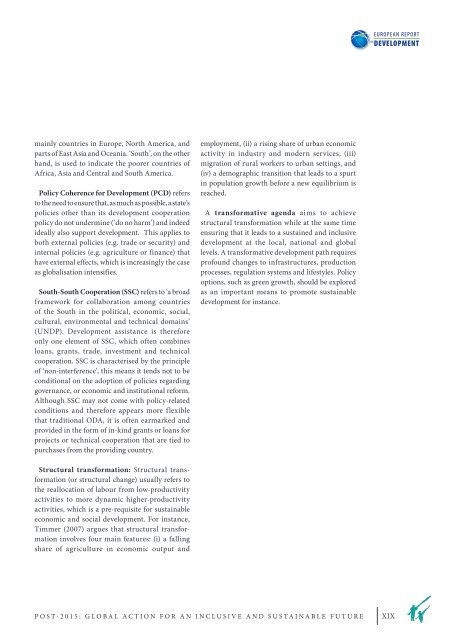Post 2015: Global Action for an Inclusive and Sustainable Future
Post 2015: Global Action for an Inclusive and Sustainable Future
Post 2015: Global Action for an Inclusive and Sustainable Future
You also want an ePaper? Increase the reach of your titles
YUMPU automatically turns print PDFs into web optimized ePapers that Google loves.
mainly countries in Europe, north america, <strong>an</strong>d<br />
parts of East asia <strong>an</strong>d oce<strong>an</strong>ia. ‘South’, on the other<br />
h<strong>an</strong>d, is used to indicate the poorer countries of<br />
africa, asia <strong>an</strong>d central <strong>an</strong>d South america.<br />
Policy Coherence <strong>for</strong> Development (PCD) refers<br />
to the need to ensure that, as much as possible, a state’s<br />
policies other th<strong>an</strong> its development cooperation<br />
policy do not undermine (‘do no harm’) <strong>an</strong>d indeed<br />
ideally also support development. this applies to<br />
both external policies (e.g. trade or security) <strong>an</strong>d<br />
internal policies (e.g. agriculture or fin<strong>an</strong>ce) that<br />
have external effects, which is increasingly the case<br />
as globalisation intensifies.<br />
South-South Cooperation (SSC) refers to ‘a broad<br />
framework <strong>for</strong> collaboration among countries<br />
of the South in the political, economic, social,<br />
cultural, environmental <strong>an</strong>d technical domains’<br />
(unDp). Development assist<strong>an</strong>ce is there<strong>for</strong>e<br />
only one element of SSc, which often combines<br />
lo<strong>an</strong>s, gr<strong>an</strong>ts, trade, investment <strong>an</strong>d technical<br />
cooperation. SSc is characterised by the principle<br />
of ‘non-interference’, this me<strong>an</strong>s it tends not to be<br />
conditional on the adoption of policies regarding<br />
govern<strong>an</strong>ce, or economic <strong>an</strong>d institutional re<strong>for</strong>m.<br />
although SSc may not come with policy-related<br />
conditions <strong>an</strong>d there<strong>for</strong>e appears more flexible<br />
that traditional oDa, it is often earmarked <strong>an</strong>d<br />
provided in the <strong>for</strong>m of in-kind gr<strong>an</strong>ts or lo<strong>an</strong>s <strong>for</strong><br />
projects or technical cooperation that are tied to<br />
purchases from the providing country.<br />
Structural tr<strong>an</strong>s<strong>for</strong>mation: Structural tr<strong>an</strong>s<strong>for</strong>mation<br />
(or structural ch<strong>an</strong>ge) usually refers to<br />
the reallocation of labour from low-productivity<br />
activities to more dynamic higher-productivity<br />
activities, which is a pre-requisite <strong>for</strong> sustainable<br />
economic <strong>an</strong>d social development. For inst<strong>an</strong>ce,<br />
timmer (2007) argues that structural tr<strong>an</strong>s<strong>for</strong>mation<br />
involves four main features: (i) a falling<br />
share of agriculture in economic output <strong>an</strong>d<br />
employment, (ii) a rising share of urb<strong>an</strong> economic<br />
activity in industry <strong>an</strong>d modern services, (iii)<br />
migration of rural workers to urb<strong>an</strong> settings, <strong>an</strong>d<br />
(iv) a demographic tr<strong>an</strong>sition that leads to a spurt<br />
in population growth be<strong>for</strong>e a new equilibrium is<br />
reached.<br />
a tr<strong>an</strong>s<strong>for</strong>mative agenda aims to achieve<br />
structural tr<strong>an</strong>s<strong>for</strong>mation while at the same time<br />
ensuring that it leads to a sustained <strong>an</strong>d inclusive<br />
development at the local, national <strong>an</strong>d global<br />
levels. a tr<strong>an</strong>s<strong>for</strong>mative development path requires<br />
profound ch<strong>an</strong>ges to infrastructures, production<br />
processes, regulation systems <strong>an</strong>d lifestyles. policy<br />
options, such as green growth, should be explored<br />
as <strong>an</strong> import<strong>an</strong>t me<strong>an</strong>s to promote sustainable<br />
development <strong>for</strong> inst<strong>an</strong>ce.<br />
poSt-<strong>2015</strong>: <strong>Global</strong> actIon For <strong>an</strong> IncluSIvE <strong>an</strong>D SuStaInablE FuturE<br />
xIx

















